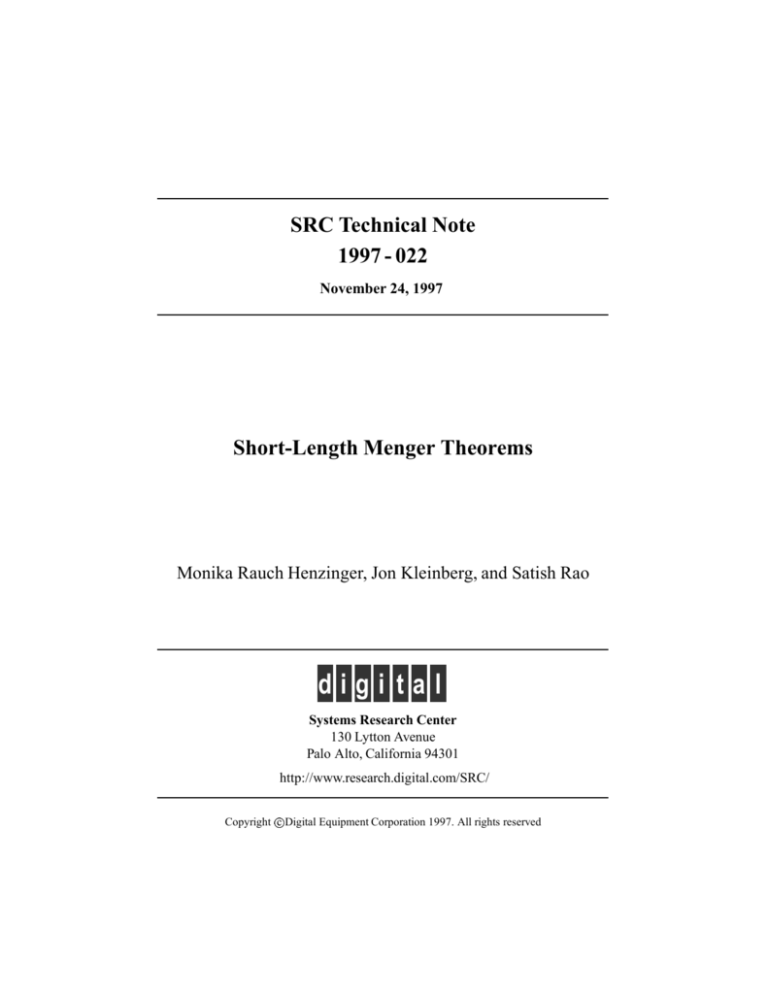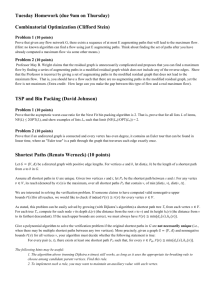
SRC Technical Note
1997 - 022
November 24, 1997
Short-Length Menger Theorems
Monika Rauch Henzinger, Jon Kleinberg, and Satish Rao
digi tal
Systems Research Center
130 Lytton Avenue
Palo Alto, California 94301
http://www.research.digital.com/SRC/
Copyright c Digital Equipment Corporation 1997. All rights reserved
Jon Kleinberg is at Cornell University. His electronic mail address is: kleinber@cs.cornell.edu.
Satish Rao is at the NEC Research Institute. His electronic mail address is:
satish@research.nj.nec.com.
1
Abstract
We give short and simple proofs of the following two theorems by Galil
and Yu [3]. Let s and t be two vertices in an n-node graph G.
√
(1) There exist k edge-disjoint s-t paths of total length O(n k).
(2) If we additionally assume that the minimum degree of G is at least k, then
there exist k edge-disjoint s-t paths, each of length O(n/ k).
Let G = (V , E) be an undirected n-node graph, with no parallel edges, and
let s and t be two vertices of G such that there exist k edge-disjoint s-t paths. Our
goal is to give short proofs of the following two theorems of Galil and Yu [3].
√
Theorem 1 There exist k edge-disjoint s-t paths of total length O(n k).
Theorem 2 If we additionally assume that the minimum degree of G is at least k,
then there exist k edge-disjoint s-t paths, each of length O(n/k).
We view G as a directed graph by replacing each undirected edge by two oppositely oriented directed edges. Our proof of the first theorem is based on a maximum flow algorithm of Even and Tarjan [2]; for our purposes, we need only consider its global structure. The algorithm of [2] runs in phases numbered 1, 2, . . .. In
phase d, a residual graph is maintained as a layered directed graph: the endpoints
of each edge lie either in the same layer or in adjacent layers, and the distance from
s to t is equal to d. The algorithm finds augmenting s-t paths of length d in this
layered graph until there exist no more such paths of length at most d; the phase
then ends.
Proof of Theorem 1. We analyze the behavior of the Even-Tarjan algorithm for
producing a flow of value k in G. We prove an upper bound on the total length
of all augmenting paths found; this also upper bounds the total length of the flow
paths. We set ` = 2nk −1/2. We say that an augmenting path is of type 0 if its length
is at most `, and of type i (i ≥ 1) if its length is √
between 2i−1 · ` and 2i · `. The
total length of all type 0 paths is at most k` = 2n k. To bound the total length of
all type i paths, for i ≥ 1, note that at the start of phase 2i−1 · ` of the Even-Tarjan
algorithm, there is some pair of adjacent layers in the residual graph whose union
contains at most n/(2i−2 · `) vertices. Between this pair of layers there can be at
most n 2/(22i−2 · `2 ) edges, and hence at most this many augmenting paths can be
produced from phase 2i−1 · ` onward. Thus the total
length of all type i paths is at
√ −i
2 −2i+2 −2
i
2 −1 −i
most (n 2
` ) · (2 `) = 4n √
` 2 =√ 2nP k2 , and so√the total length of
all augmenting paths is at most 2n k + 2n k i≥1 2−i = 4n k.
For the proof of the second theorem, we consider the problem of finding a set
of k edge-disjoint s-t paths in G whose total length is minimum. Let P1 , . . . , Pk
2
be such a set of paths; say that an edge e is a flow edge if it is contained in some Pi ,
and a non-flow edge otherwise. Observe that if (u, v) is a flow edge, then by the
optimality of P1, . . . , Pk , (v, u) is not a flow edge. Finding k edge-disjoint paths
of minimum total length is a minimum-cost flow problem; if we take its linear
programming dual, we obtain dual variables yv , one for each v ∈ V , which are
integers with the following properties. (See e.g. [1].)
(1) If (u, v) is a flow edge, then yv − yu ≥ 1.
(2) If neither (u, v) nor (v, u) is a flow edge, then yu and yv differ by at most
1.
(3) We may assume without loss of generality that ys = 0, yt ≥ 0, and for
every j in the interval [0, yt ], there exists a node v with yv = j . We define X i =
{v : yv = i}.
Proof of Theorem 2. We claim that for each i ∈ [0, yt − 3], ∪i+4
X
≥ 15 k;
j
j =i
the theorem will follow directly from this. By (3), there exist vertices u ∈ X i+1 ,
v ∈ X i+2 , and w ∈ X i+3 . Now, suppose that at most 15 k flow paths pass through
at least two of them. At least 3k − 3 edges are incident to {u, v, w}; at most
3
4 · 15 k + 2 · 45 k = 12
5 k of these are flow edges. Hence there are at least 5 k − 3 non1
flow edges incident to {u, v, w}; at least 5 k − 1 of these are incident to a single one
of these vertices. By (2), the endpoints of these non-flow edges lie in ∪i+4
j =i X j , and
i+4 1
hence ∪j =i X j ≥ 5 k.
Otherwise, at least 15 k flow paths pass through at least two of u, v, w. Now, by
(1), at most one flow path can pass through both u and v or both v and w; and at
most one can pass directly from u to w. Thus (again by (1)), at least 15 k −3 of these
1
paths must pass
from u to w via distinct vertices in X i+2 . Hence |X i+2 | ≥ 5 k − 3,
1
and so again ∪i+4
j =i X j ≥ 5 k.
References
[1] R. Ahuja, T. Magnanti, J. Orlin, Network Flows, Prentice-Hall, 1993.
[2] S. Even, R. Tarjan, “Network flow and testing graph connectivity,” SIAM J.
Computing, 4(1975), pp. 507–518.
[3] Z. Galil, X. Yu, “Short-length versions of Menger’s theorem,” Proc. 27th ACM
STOC, 1995, pp. 499–598.
3



![[#GRP-871] MembershipFinder.findMemberships doesn`t appear to](http://s3.studylib.net/store/data/007422299_1-e8f5b300a55fd76701b09e629a1c1653-300x300.png)




